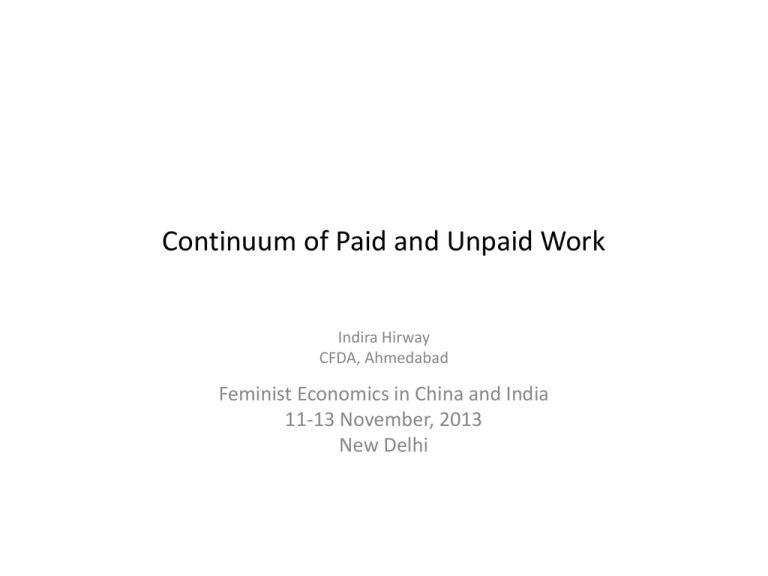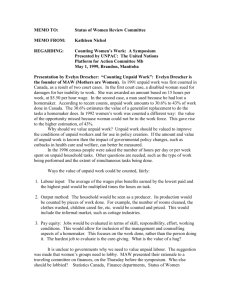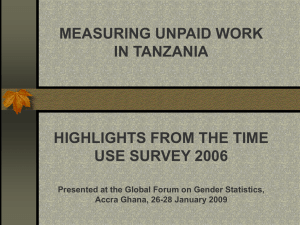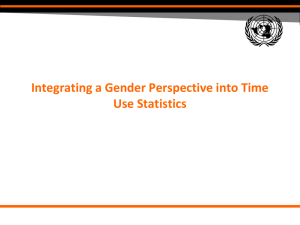Unpaid Work: Major Characteristics
advertisement

Continuum of Paid and Unpaid Work Indira Hirway CFDA, Ahmedabad Feminist Economics in China and India 11-13 November, 2013 New Delhi Unpaid Work: Major Characteristics • What is unpaid work? – Within production boundary – Within General Production Boundary • Major characteristics of unpaid work under General Production Boundary – – – – – Significant in size and important role in the economy Unequal sharing Mostly invisible and outside the purview of policy making Low productivity – frequently drudgery Division based on social norms – no free choice. Continued…. • Unpaid work is inferior work – – – – Work is repetitive, boring Without much prospects for upward mobility – dead end job No (Fixed) retirement, no benefits like pension etc. Not under any regulation/laws etc • Women carry higher burden of total work – Frequently resulting in time poverty (time stress) and loss of well being of women - even when the HH is above poverty – Time allocation among different activities also trap the poor in poverty Activity Av time UP-M Av time UP-F Av time NP-M Av time NP-F HH mangmt etc 1.97 25.62 1.18 30.64 care 2.87 6.20 0.51 4.05 Comm services 0.04 0.04 1.18 0.27 Sub total 4.28 30.86 3.77 34.86 Learning 11.05 4.79 13.08 7.29 Socialisation 3.13 2.15 6.26 6.07 Personal care 103.37 99.66 100.80 95.36 Total personal care 117.55 108.60 119.04 110.72 Total Work –SNA & non SNA 53.14 58.72 48.83 54.49 Continuum of paid and unpaid work • Production process takes place in the market and nonmarket spheres – till consumption takes place • Human capital formation takes place in the market and non-market spheres • Demarcation between what goes in the national income and what does not is an arbitrary compromise • The demarcation leaves out women’s work – it has a gender bias – not backed by any logic – it is a line based on patriarchal values Implications of the demarcation line • It gives cloak of invisibility to women’s work • Productivity, working conditions, skills and technology, social protection etc of unpaid work fall outside the purview of policy making. • Macroeconomics neglect this work and also the workers. • Policy makers worry about part of their work –visible work – and discuss superficial issues without going to the core. Trends in the recent years • Increase in labour intensive exports and unpaid work. • Improvement in labour market status (regular employment) and unpaid work. • Participation in MGNREGA and unpaid work. • Neglect of unpaid work results in macro economic losses. Public policy and unpaid work • Visibility and mainstreaming time use surveys • Scattered, isolated and small scale programmes have not made much impact. • Unpaid work is viewed and treated in isolation – mainly through welfare programmes Unpaid work needs to be treated as a part of macro economy • Unpaid work is the lagging sector in the economy, as no adequate policy attention is paid to the work and workers in this sector. • It is a sub-optional use of labour in the economy where the division of work is based on gender and not on efficiency or productivity. • It is unjust to unpaid workers – violation of human rights of women. • Its exclusion from macroeconomics is not only a gender issue, but a core macroeconomic issue.











